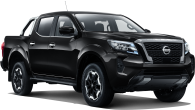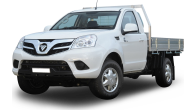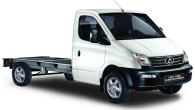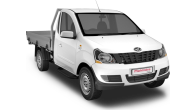VW’s 4x4 Amarok V6, although an excellent performer, has not posed a threat to the sales dominance of the Toyota HiLux and Ford Ranger in Australia’s 4x4 ute market. Beyond brand loyalties or prejudices, one of the greatest barriers to sales growth has been the German ute’s high pricing, as it has struggled to match less powerful competitors built in Thailand with their low manufacturing costs and free-trade agreements.
Even so, VW has recently tried to address this issue with the release of the Core TDI 550 V6, with pricing much closer to $50,000. This brings Amarok’s outstanding 3.0 litre V6 capabilities within the reach of more ute buyers, but in the Core’s more basic work-focused specification. We recently spent a week behind the wheel to see if it hits the target.
Volkswagen Amarok 2018: V6 Tdi 550 Core
| Engine Type | Diesel Turbo V6, 3.0L |
|---|---|
| Fuel Type | Diesel |
| Fuel Efficiency | 9.0L/100km (combined) |
| Seating | 5 |
| Price From | $25,080 - $31,020 |
Is there anything interesting about its design?
The V6 drive-train brings a 210kg increase in tare weight; our test vehicle weighing in at 2091kg compared to the four-cylinder Core at 1873kg. However, the impressive firepower of the larger six-cylinder engine more than compensates for this weight increase, plus you get the extra bite of 300mm ventilated disc brakes on the rear axle in place of the usual drums. It also has 34mm less ground clearance than the four-cylinder model (192mm vs 226mm).
.JPG)
What are the key stats for the engine and transmission?
With its Porsche and Audi heritage this 3.0 litre turbo-diesel V6 is a great engine. With the Mercedes-Benz X350d it shares the class benchmark for torque at 550Nm, which in the Amarok is available across a 1000rpm-wide rev band between 1500-2500rpm. Its 165kW is 25kW short of its German rival, but with the Core’s 113kg lighter kerb weight the acceleration feels just as meaty and forceful in its peak power zone between 2500-4500rpm.
A 180kW over-boost function, which unleashes an extra 15kW for durations of up to 10 seconds, can be accessed in third or fourth gear at throttle openings of more than 70 per cent, which is obviously ideal for overtaking quickly and safely on two-lane highways.
The eminently refined eight-speed torque converter automatic has always been a superb performer, with near-seamless changes between its close ratios thanks to intelligent shifting protocols which ensure the engine is always in its optimum gear. You can also manually change using the console shifter, which is handy at times when hauling heavy loads, but for most driving it’s best in set-and-forget auto mode.
.JPG)
The 4Motion single-range permanent 4x4 system with its well calibrated traction control works brilliantly on and off-road, particularly with the V6’s big power and torque outputs and glacial crawling speeds provided by the low 4.7:1 first gear.
4Motion allows you to leave the bitumen and tackle the toughest terrain without having to change a thing, although the driver has several switchable options on the console to play with including a dedicated off-road mode, cancellation of the road-biased stability control and engagement of the rear diff lock.
How much fuel does it consume?
VW’s combined figure of 9.0 litres/100km was pretty close to the dashboard display showing a neat 10L/100km average at the end of our test drive. And that was even closer to our own figure of 10.7, crunched from fuel bowser and trip meter readings after 617km of testing with a variety of loads (including maximum GVM) on sealed and unsealed roads.
Although that’s slightly higher than the peerless 9.6 figure we achieved in the X350d after similar use, it’s still excellent economy for a 3.0 litre V6 that offers such hearty performance. With its 80-litre tank you could expect a driving range of around 750km.
How practical is the space inside?
With a tare weight of 2091kg and 3080kg GVM, the Core V6 has a payload rating of 989kg (minus the 70 litres of diesel missing from the tare weight figure, which weighs about 58kg). 100kg of that payload can be carried on the roof.
The Core V6 is also rated to tow up to the class benchmark 3500kg of braked trailer but with a 6000kg GCM (or how much it can legally carry and tow at the same time) that 989kg payload would need to be reduced by a substantial (and let's face it, impractical) 580kg to avoid exceeding the GCM limit. And that would leave you with just over 400kg of payload capacity, which is enough for about four large adults - with no luggage.
Our test vehicle was fitted with a full tub-liner which is an accessory we would highly recommend for any hard-working ute. The spacious load tub includes an overhead work light (on the rear of the cabin) and four sturdy tie-down points, but the rear ones are too far forward for our liking.
The broad 1222mm between the wheel arches means it’s in rare company by being able to swallow a standard 1165mm-square Aussie pallet. We know it’s a cost-crunching model, but given its work focus the addition of a 12-volt socket and rear window protection frame with load retainers as standard would be most handy here.
Cabin storage includes a bottle holder and storage bin in the base of each front door plus a shallow storage tray set into the centre dash-pad, a single lockable glovebox and overhead glasses holder. The centre console has a small open bin at the front, two cup holders in the centre and a lidded box at the rear which doubles as an armrest.
.JPG)
There’s also a bottle holder and storage bin in each rear door, plus flexible storage pockets on the front seat backrests. The 60/40-split rear seat base cushion can be swung up and secured in a vertical position if greater internal carrying space if required.
What’s it like to drive?
Driver and front passenger access and comfort is excellent, but those in the rear seat can feel cramped (particularly large adults) due to tighter entry and exit, limited knee room and a very upright seating position which can be uncomfortable and tiresome on long journeys.
Acceleration is vigorous at all speeds and particularly impressive from standing starts. The Core V6 belies its two-tonne plus kerb weight with an instant and unrelenting surge between 2500-4500rpm that has the speedo hitting triple digits from zero very smartly.
Combined with the superb weight and feel of the Amarok’s power-assisted rack and pinion steering, predictable and responsive handling, permanent four-wheel-drive and a big disc brake inside each wheel, it drives more like a big powerful car than a truck. And that applies on bitumen or dirt, empty or full.
Wind and engine noise is low, particularly at highways speeds where the loudest intrusion is subdued tyre roar on coarse bitumen surfaces. The gearing for the big V6 is ideal for highway work, loping along within its peak torque zone with only 1700rpm at 100km/h and 1800rpm at 110km/h.
The ride is noticeably firm and, when empty or lightly loaded, it can feel a tad too firm. However, the ride becomes much smoother with a big load on board, to compress those big rear leaf-spring packs and give them the sprung weight they need to do their best work.
.JPG)
We duly obliged with 830kg in the load tub, which with driver and a full tank of diesel equalled the lower (kerb weight-based) 930kg payload limit. The rear springs compressed a full 60mm and the nose rose 15mm, resulting in a spirit-level ride height.
Needless to say, it handled this peak payload with consummate ease, doing a good job of pretending it wasn’t there. Handling remained sure-footed and largely unaffected.
It also seemed to laugh out loud at our 13 per cent gradient 2.0km long set climb, self-shifting down to fifth at 1800rpm and easily pulling this big payload all the way to the top at 60km/h with the right foot barely touching the accelerator pedal.
Also impressive was its engine braking on the way down. In a manually-selected second gear the V6 confidently restrained this load without us once having to touch the brakes, reaching a maximum speed of only 50km/h and 4200rpm on over-run.
That is by far the best engine-braking we’ve seen this side of the Land Cruiser 70 Series’ much larger 4.5 litre V8 and a real bonus if you’re planning to carry or tow big loads, particularly in hilly country.
Warranty & Safety Rating
What safety equipment is fitted? What safety rating?
7 / 10
The four-cylinder Amarok earned the maximum five-star ANCAP rating back in 2011 but the V6 version still has no rating. There’s also no AEB, so the best it could earn is four stars under today’s tougher testing regime.
Even so, there’s still an impressive list of features on the electronic stability menu including trailer sway control, but only if you opt for the genuine VW tow-bar wiring kit. Driver and front passenger get front airbags and side (head and thorax) airbags. Rear seat passengers still have no curtain airbag protection, another glaring safety omission, but there are three headrests, lap-sash belts and top tether child seat anchorage points plus ISOFIX fittings on the two outer seating positions.
What does it cost to own? What warranty is offered?
Five year/unlimited km warranty for vehicles sold on or after January 1, 2019, which is transferable to a new owner during the warranty period. Includes 12 months complimentary roadside assist. Service intervals of 12 months/15,000km whichever occurs first. Capped pricing for first five scheduled services range between $515 and $878 (or $3228 in total) but optional pre-paid servicing packages offer considerable savings.
Verdict
If you want big V6 grunt without the big price tag of higher-grade models, the Amarok Core V6 is fit-for-purpose and ticks most boxes, apart from its cramped rear seating and increasingly dated safety ratings. It’s not only powerful and engaging to drive but heavy load-hauling ability is one of its greatest strengths. So even if you’ve never considered owning a ute with a German badge, this one is at least worth a decent test drive – because one drive just might change your mind.
Would you consider a 4x4 Volkswagen Amarok Core V6 over a Toyota HiLux or Ford Ranger? Tell us in the comments below.
Pricing Guides








.jpg)
.JPG)
.JPG)
.JPG)
.JPG)
.JPG)
.JPG)
.JPG)
.JPG)

















.jpg)

.jpg)



.jpg)